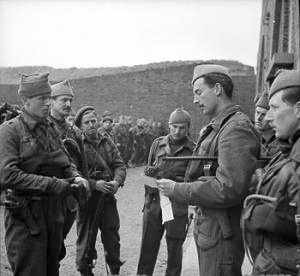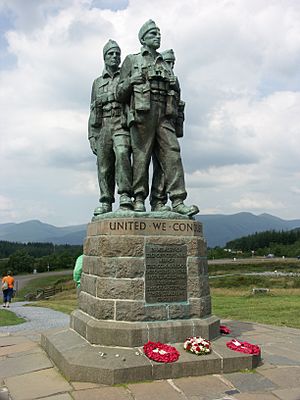Cap comforter facts for kids
Quick facts for kids Cap, Comforter |
|
|---|---|

Lord Lovat and other British commandos wearing cap comforters in 1942
|
|
| Place of origin | United Kingdom |
| Service history | |
| In service | 19th century–Present |
| Used by | United Kingdom Australia Netherlands |
| Wars | First World War Second World War Afghanistan War |
A cap comforter is a special type of woollen hat. It was first used by the British Army.
It looks like a knitted wool tube, a bit like a short scarf. Soldiers usually pull it over their head to wear it as a hat. It fits easily under a Brodie helmet, which is a type of military helmet. Sometimes, it's sewn shut at one or both ends. This hat has no special badges or symbols. It's also easy to fold and store without getting creased.
Contents
History of the Cap Comforter
Cap comforters first appeared in the late 1800s. British soldiers wore them for everyday tasks around camp. They were also a comfortable hat to wear when not in battle.
First World War Use
During the First World War, cap comforters were very popular. They were a warm choice instead of the usual service dress cap. Soldiers could pull them low over their ears to stay warm in the cold winter trenches. Their soft, flexible shape made them perfect for secret night missions called trench raids.
Second World War Use
In the Second World War, soldiers in many British and Canadian groups wore cap comforters. They used them during training and when doing manual jobs.
Commandos and Their Hats

The British commandos were a special group of soldiers. They came from many different Allied units. Each unit had its own unique hat. To make everyone look more alike, commando units chose their own practical headgear. No. 1 Commando picked the green beret. Other units, like No. 4 Commando, chose the cap comforter. They liked it because it wasn't linked to any specific country or army group before.
In late 1942, the War Office made the green beret the official commando hat. But the cap comforter was still worn often. It had already become a symbol of the commandos.
After the Wars
Canada's Toques
Since 1945, Canada has used many knitted hats for its soldiers. But they now call them "toques" instead of "cap comforters."
United Kingdom's Headovers
The British Army no longer gives out cap comforters. They now use "headovers" instead. These are similar items, but they are not sewn at the ends. This means they can be worn like balaclavas, covering more of the face. However, some special units, like the Royal Marines, still use cap comforters. Soldiers wear them during tough training courses.
Netherlands' Green Berets
Soldiers in the Dutch Korps Commandotroepen also wear the cap comforter. They wear it until they pass their tough selection course. After passing, they earn the right to wear a green beret.

